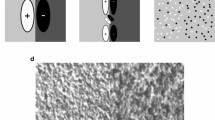Abstract
Beck (1972, 1973) hypothesized that textural segmentation occurs strongly on the basis of simple properties such as brightness, color, size, and the slopes of contours and lines of the elemental descriptors of a texture or textural elements. The experiment reported supports the hypothesis that specific stimulus features, rather than second-order statistics, account for textural segmentation. The results agree with Julesz (1981a, b) who has reported evidence disproving his original conjecture of the importance of second-order statistics. Julesz (1981a, b) now hypothesizes textural segmentation to be a function of local features which he called textons. Textons are features that give textural segmentation when textures have identical second-order statistics. The two hypotheses are to date in complete agreement on the stimulus features producing textural segmentation, and the experiment reported is consistent with both.
Similar content being viewed by others
References
Beck, J.: Similarity grouping and peripheral discriminability under uncertainty. Am. J. Psychol. 85, 1–19 (1972)
Beck, J.: Similarity grouping of curves. Percept. Motor Skills 36, 1331–1341 (1973)
Beck, J.: Textural segmentation. In: Organization and representation in perception, Beck, J. (ed.). Hillsdale, NJ: Lawrence Erlbaum Associates 1982, pp. 285–317
Beck, J., Prazdny, K., Rosenfeld, A.: A theory of textural segmentation. In: Human and machine vision, Beck, J., Hope, B., Resenfeld, A. (eds.) New York: Academic Press (in press)
Caelli, T.M.: Facilitative and inhibitory factors in visual texture discrimination. Biol. Cybern. 39, 21–26 (1980)
Julesz, B.: Experiments in the visual perception of texture. Sci. Am. 232, 34–43 (1975)
Julesz, B.: Spatial nonlinearities in the instantaneous perception of texture with identical power spectra. Philos. Trans. R. Soc. London B 290, 83–94 (1980)
Julesz, B.: A theory of preattentive texture discrimination based on first-order statistics of textons. Biol. Cybern. 41, 131–138 (1981) (a)
Julesz, B.: Textons, the elements of texture perception, and their interactions. Nature (London) 290, 91–97 (1981) (b)
Julesz, B., Gilbert, E.N., Shepp, L.A., Frisch, H.L.: Inability of humans to discriminate between visual textures that agree in second-order statistics-revisited. Perception 2, 391–405 (1973)
Marr, D.: Early processing of visual information. Philos. Trans. R. Soc. London B 275, 483–524 (1976)
Wertheimer, M.: Untersuchungen zur Lehre von der Gestalt. II. Psychol. Forsch. 4, 301–350 (1923)
Author information
Authors and Affiliations
Additional information
This research was supported in part by the National Science Foundation under Grant MCS-79-23-4222 to the Computer Vision Laboratory, University of Maryland. I am grateful to David Notley and Peter Hyde for writing the programs that generated the stimuli and computed the dipole statistics, and to Azriel Rosenfeld for valuable discussions
Rights and permissions
About this article
Cite this article
Beck, J. Textural segmentation, second-order statistics, and textural elements. Biol. Cybern. 48, 125–130 (1983). https://doi.org/10.1007/BF00344396
Received:
Issue Date:
DOI: https://doi.org/10.1007/BF00344396




